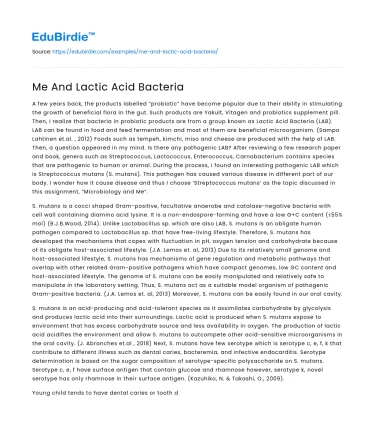Introduction
Lactic acid bacteria (LAB) have long been an integral part of human civilization, dating back to ancient times when they were used in the fermentation of foods. These microorganisms, which primarily include genera such as Lactobacillus, Leuconostoc, Streptococcus, and Pediococcus, are renowned for their ability to convert carbohydrates into lactic acid. This process not only preserves food but also enhances its nutritional value and digestibility. With growing interest in probiotics and gut health, LAB have attracted significant scientific attention. This essay explores the multifaceted relationship between humans and lactic acid bacteria, examining their role in food production, health benefits, and potential challenges. By understanding both the historical significance and contemporary applications of LAB, we can appreciate their contribution to human well-being.
The Role of Lactic Acid Bacteria in Food Fermentation
Lactic acid bacteria have been pivotal in the history of food fermentation. According to a study by Axelsson (2004), LAB are responsible for the fermentation of dairy products, vegetables, and meats, which are staples in various cultural cuisines. The metabolic activity of LAB leads to the production of lactic acid, reducing the pH and thereby inhibiting the growth of spoilage organisms and pathogens. This natural preservation method has been harnessed for centuries, as seen in the traditional preparation of sauerkraut, kimchi, and yogurt.
Save your time!
We can take care of your essay
- Proper editing and formatting
- Free revision, title page, and bibliography
- Flexible prices and money-back guarantee
The fermentation process not only extends shelf life but also enhances the nutritional profile of foods. For instance, LAB fermentation increases vitamin content, as noted by Caplice and Fitzgerald (1999), who observed an increase in B vitamins in fermented dairy products. Additionally, LAB can break down complex carbohydrates and proteins, making them more digestible. This is particularly beneficial for individuals with lactose intolerance, as LAB in yogurt can hydrolyze lactose, easing digestion (de Vrese et al., 2001).
Despite these benefits, there are challenges associated with the use of LAB in food fermentation. The variability in strains can lead to inconsistent flavor and texture profiles, which is critical for consumer acceptance. Moreover, the safety of fermented foods depends on the initial microbial load and fermentation conditions. Nevertheless, modern biotechnological advancements have facilitated the selection and optimization of LAB strains to ensure consistent quality and safety in fermented products.
Health Benefits and Probiotic Potential of Lactic Acid Bacteria
The health-promoting properties of LAB are largely attributed to their probiotic potential. Probiotics are live microorganisms that confer health benefits to the host when administered in adequate amounts (FAO/WHO, 2002). Numerous studies have demonstrated the positive impact of LAB on gut health, including the modulation of gut microbiota, enhancement of intestinal barrier function, and stimulation of immune responses (Sanders et al., 2013).
For example, Lactobacillus rhamnosus GG is one of the most extensively studied LAB strains, known for its ability to prevent and alleviate gastrointestinal disorders such as diarrhea and irritable bowel syndrome (Ouwehand et al., 2002). Furthermore, LAB have been associated with the reduction of cholesterol levels, as evidenced by the work of Jones et al. (2012), who found that certain LAB strains can assimilate cholesterol in vitro.
However, the efficacy of LAB as probiotics is not without debate. Critics argue that not all LAB strains exhibit probiotic effects, and the health benefits observed in controlled studies may not always translate to real-world scenarios. Additionally, the survivability of LAB through the gastrointestinal tract remains a challenge. Despite these counterarguments, ongoing research and technological advancements continue to support the development of effective LAB-based probiotics.
Challenges and Future Directions in LAB Applications
While the benefits of LAB are well-documented, several challenges must be addressed to maximize their potential applications. One significant challenge is the strain-specific nature of LAB effects, which requires precise identification and characterization of probiotic strains. Advances in genomics and bioinformatics have facilitated this process, enabling the design of targeted probiotic formulations tailored to individual health needs (Hutkins et al., 2016).
Moreover, the industrial production of LAB poses logistical and economic challenges. The cultivation and storage of live cultures require stringent conditions to maintain viability and efficacy. Innovative encapsulation technologies and novel delivery systems are being explored to enhance the stability and delivery of LAB in various matrices (Champagne et al., 2018).
Looking forward, the integration of LAB in functional foods and personalized nutrition offers promising avenues for research and commercial development. As consumer awareness of gut health and probiotics continues to rise, the demand for LAB-based products is expected to grow. By addressing the current challenges and leveraging scientific advancements, the full potential of LAB in promoting human health and well-being can be realized.
Conclusion
In conclusion, lactic acid bacteria play a crucial role in food fermentation and human health. Their historical and contemporary significance in food preservation and nutrition highlights their enduring value. While challenges exist, particularly regarding strain specificity and probiotic efficacy, the advancements in biotechnology and genomics provide promising solutions. The future of LAB applications is bright, with potential innovations in personalized nutrition and functional foods. As research continues to unravel the complexities of LAB, their integration into daily life as both food and therapeutic agents will likely expand, offering new opportunities for enhancing human health.
The journey of exploring lactic acid bacteria reflects a broader narrative of how microorganisms, often unseen and undervalued, can profoundly impact human life. By continuing to study and harness these tiny yet mighty allies, we pave the way for a healthier, more sustainable future.






 Stuck on your essay?
Stuck on your essay?

